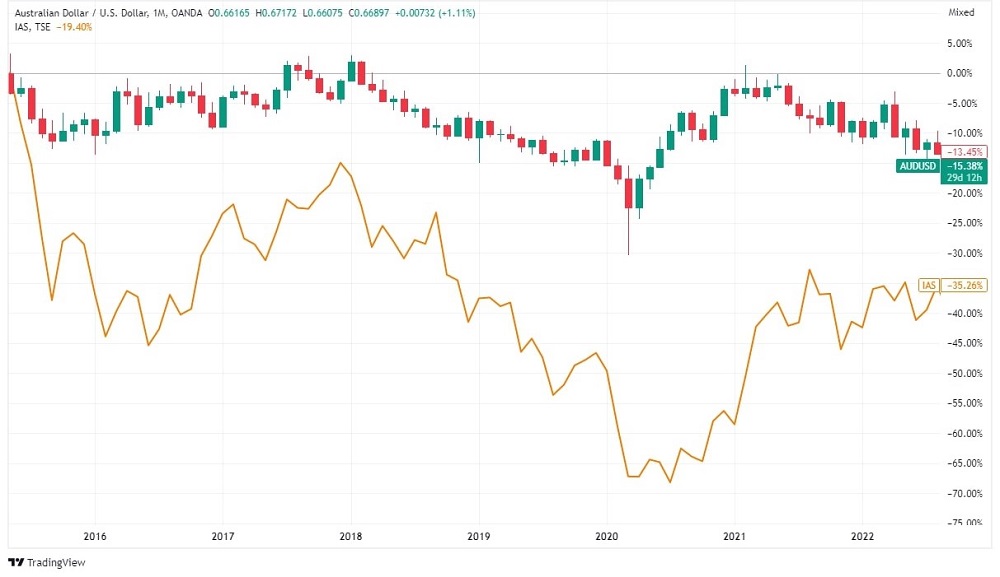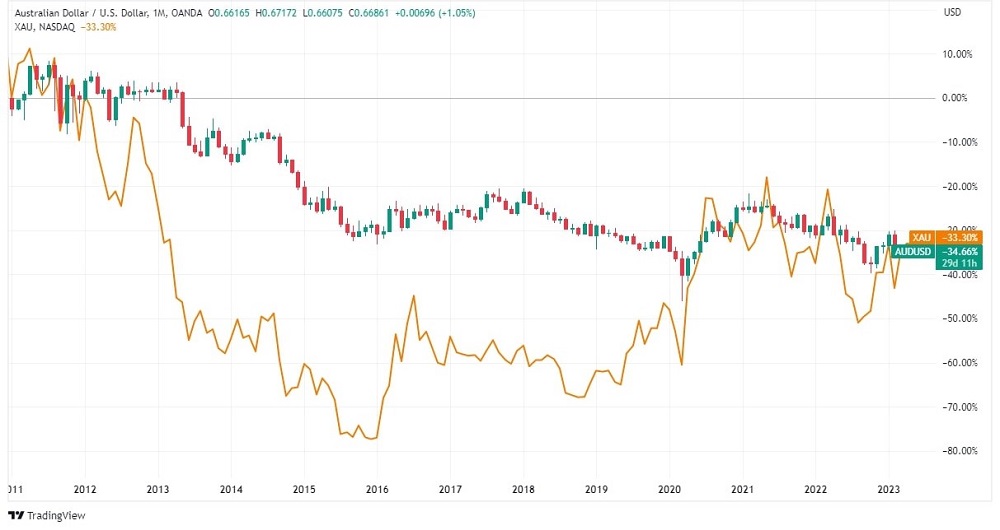The Australian Dollar's movements are heavily influenced by commodity prices. When commodity prices rise, it makes AUD robust. Here's the explanation.
In terms of trading, the Australian Dollar's correlation with commodity prices can be utilized to determine its price movements. When commodity prices rise, it makes Australian exports more valuable, strengthening the Australian dollar. Conversely, when commodity prices fall, Australian exports are less valuable, weakening the Australian dollar.
Traders can use this relationship between commodity prices and the Australian dollar to make predictions about the future direction of the Australian dollar. For example, if they believe that commodity prices are going to rise, they might buy Australian dollars in anticipation of the currency's strengthening.
Here are some effects of commodity prices on the Australian Dollar and their use in trading analysis.
- Commodity prices and the Australian dollar move in the same direction.
- Commodity prices are in opposition to the US Dollar.
- Commodity prices are positively correlated with AUD/USD.
- The correlation between gold prices and AUD/USD is as high as 80 percent.
- The relationship between commodity prices and the Australian Dollar can be used as a basis for fundamental analysis for the AUD/USD pair.
Still not clear on the 5 points above? Let's see a more complete explanation one by one below.
The Effect of Commodity Prices on AUD/USD
If we look at the history of the forex market, the Australian Dollar, "The Aussie" occupies the fifth position as the most traded currency. Its participation in 2013 alone amounted to 8.6 percent of all trades.
The Australian dollar (AUD) is a commodity currency, meaning its value is closely linked to the prices of commodities. As the largest exporters of commodities in mining and agriculture, the AUD, CAD, and NZD exchange rates are closely linked to the US Dollar (USD) as commodity price quotes in international trade are generally quoted in US Dollars.
The AUD/USD price reflects the fundamental strength of the Australian Dollar against the US Dollar. Therefore, there is a close correlation with commodity prices, which are the main source of income for "the land of Kangaroos".
Australia is one of the largest exporters of mining materials in the world. High commodity exports drove its rapid growth to become a world economic giant.
The main commodities exported by Australia include iron ore and its concentrates, coal, gas, oil, and gold. Two of these, iron ore and gold, correlate positively to the price movements of AUD/USD. Take a look at the chart below, which compares the price movement of iron ore against AUD/USD.

From the chart above, we can see that in the medium to long run, the iron ore price trend with AUD/USD is moving in the same direction.
This condition also happens for the price of gold with AUD/USD. As you can see in the chart below, the price movements of gold and AUD/USD display almost the same ups and downs.

As of today, Australia is still the third-largest gold producer in the world. The value of gold exported by Australia was once recorded at more than 5 billion dollars. The correlation between the two is allegedly as high as 80 percent, much more significant than the correlation between iron ore prices with AUD/USD. So, it's normal that when gold prices go up, AUD/USD goes up too.
Intermarket Analysis of Commodity Prices and AUD/USD
In a nutshell, intermarket analysis is an approach to understanding the interactions between stocks, bonds, commodities, and forex to spot medium to long-term trends. The correlation may not be obvious in the short term, but the impact will become clear over time.
A gold price fall, in a day or two, for instance, may not weigh much on the Australian Dollar. However, if the bearish trend continues for several months, the value of Australia's gold exports will be negatively affected. Likewise, when iron ore prices rise, AUD/USD may not react in any way. But if the bullish rally continues, AUD/USD will also rise.
Another reason why commodity prices can be positively correlated with The Aussie is that they usually move against the US Dollar. This means that commodity prices move against the US Dollar but in the same direction as the Australian Dollar and other Comdolls. As an example, the commodity price of gold with the US Dollar is poor because investors tend to convert their dollars into gold, which is considered safer in times of economic crisis.
For anyone using a swing trading strategy, this could be an important factor to watch. The same goes for long-term traders who employ a "buy and hold" strategy. Even fundamental analysis-based day traders can benefit from understanding intermarket analysis, especially when commodity price fluctuations affect a country's expected inflation, GDP, and interest rates.
Example of AUD/USD and Commodity Price Trading Analysis
As a frequently traded currency pair, AUD/USD analysis cannot be separated from the influence of commodity prices, such as iron ore, gold, etc. In addition, Australia also has a close relationship with China where Australia is a large exporter to them.
Comdoll currencies such as the Australian Dollar, Canadian Dollar, and New Zealand Dollar tend to be more stable because they are supported by commodities. This possibility is projected to remain until the end of the year, although exchange rate fluctuations can still occur.
However, the Australian Dollar and other Comdolls are more stable than risk-sensitive currencies. So, it is likely that AUD/USD in 2023 will still weaken to USD 0.6500, while AUD/JPY is expected to remain stable at 1.6740 or JPY 94.8645 per AUD.
Meanwhile, China's economic recovery could positively impact the global economy, but could also cause inflation through its effect on commodity prices. This situation could challenge the central bank's efforts to fight inflation and result in the likelihood of a rate hike or potential cut being less than expected by the market in 2023-2024.
Conclusion
The Australian dollar significantly influences commodity prices because it's the world's largest commodity exporter. Australia's economy is growing rapidly, making it a world economic giant due to its incredible commodity output. In the context of trading, you can use the influence of commodity prices on the Australian Dollar to analyze its price movements in the forex market.
Looking to trade AUD/USD? Well, in order to trade this pair successfully, you need to pay attention to many factors, especially commodity prices. To learn more, check out this AUD/USD trading guide.

 Dedicated FREE FOREX VPS
Dedicated FREE FOREX VPS Free FOREX Virtual Private Server
Free FOREX Virtual Private Server MT4 Demo Contest, Get $500
MT4 Demo Contest, Get $500 Sign Up for an Account, Claim 60% Deposit Bonus
Sign Up for an Account, Claim 60% Deposit Bonus Free MT4/MT5 VPS 2024
Free MT4/MT5 VPS 2024 Send E-mail and Get Free Merchandise
Send E-mail and Get Free Merchandise $1K Refer a Friend Bonus for Pepperstone Pro clients
$1K Refer a Friend Bonus for Pepperstone Pro clients Maximize Your Earnings with 100% Deposit bonus
Maximize Your Earnings with 100% Deposit bonus Trade to Win, $5,000 Monthly Demo Contest
Trade to Win, $5,000 Monthly Demo Contest Claim 30% + 15% Deposit Bonus from LiteFinance
Claim 30% + 15% Deposit Bonus from LiteFinance







